Leadership and Management: Analyzing Roles, Skills, and Styles
VerifiedAdded on 2021/02/09
|26
|7736
|34
Report
AI Summary
This report analyzes the key differences between leadership and management, exploring the distinct roles, responsibilities, and characteristics of each. It differentiates between a leader's focus on inspiring and empowering staff, fostering trust, and setting a vision, versus a manager's focus on executing plans, coordinating tasks, and ensuring operational efficiency. The report delves into the attributes of a leader, including trust, vision, the ability to inspire, strategy execution, and coaching. It also explores leadership styles, such as autocratic, democratic, and laissez-faire, and leadership theories like the Traits Theory, Transformational, Transactional, and Action Centered leadership. The report also addresses the vulnerabilities of leaders and the importance of soft skills. It highlights the manager's role in daily operations, planning, controlling, and coordinating activities to achieve organizational objectives. The report emphasizes the importance of both leadership and management for organizational success.
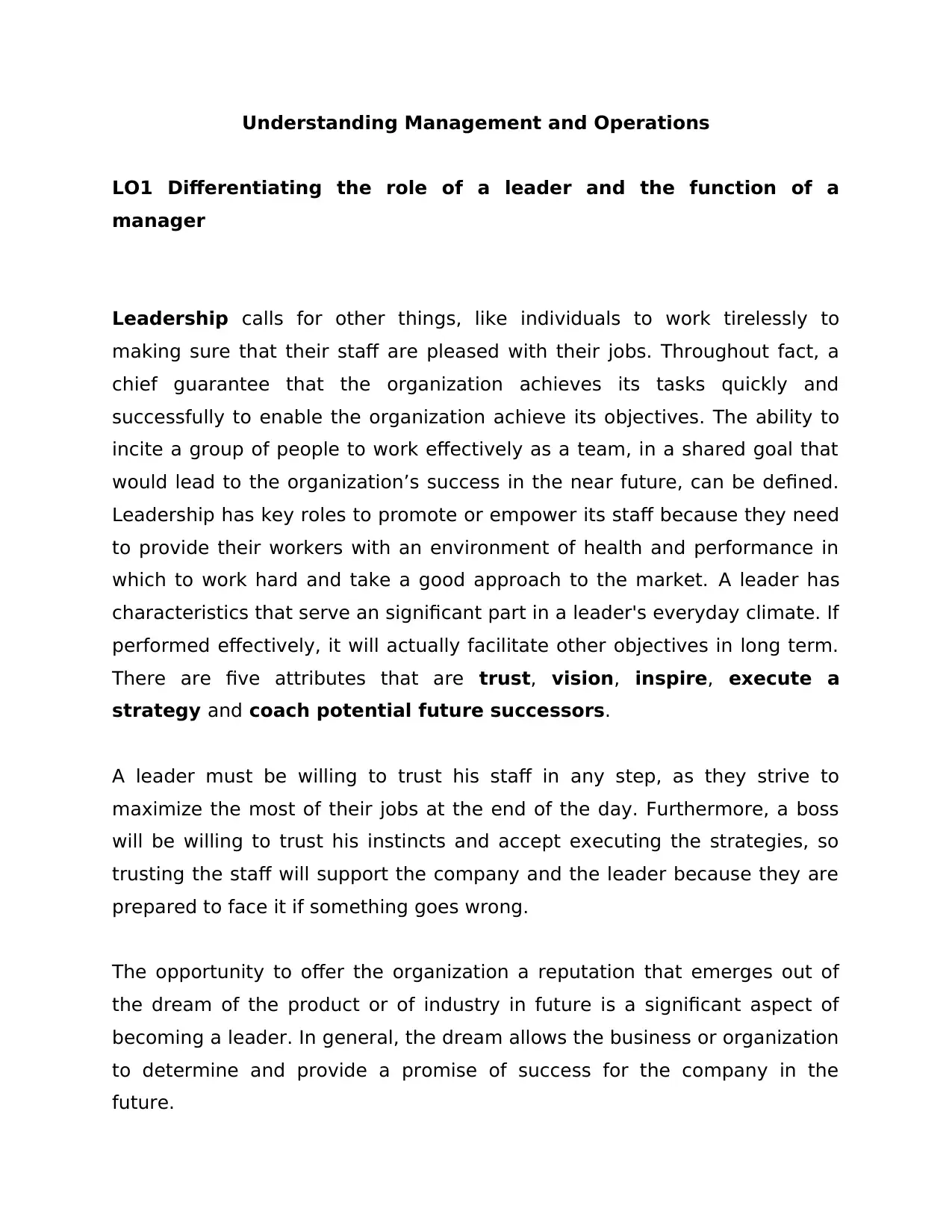
Understanding Management and Operations
LO1 Differentiating the role of a leader and the function of a
manager
Leadership calls for other things, like individuals to work tirelessly to
making sure that their staff are pleased with their jobs. Throughout fact, a
chief guarantee that the organization achieves its tasks quickly and
successfully to enable the organization achieve its objectives. The ability to
incite a group of people to work effectively as a team, in a shared goal that
would lead to the organization’s success in the near future, can be defined.
Leadership has key roles to promote or empower its staff because they need
to provide their workers with an environment of health and performance in
which to work hard and take a good approach to the market. A leader has
characteristics that serve an significant part in a leader's everyday climate. If
performed effectively, it will actually facilitate other objectives in long term.
There are five attributes that are trust, vision, inspire, execute a
strategy and coach potential future successors.
A leader must be willing to trust his staff in any step, as they strive to
maximize the most of their jobs at the end of the day. Furthermore, a boss
will be willing to trust his instincts and accept executing the strategies, so
trusting the staff will support the company and the leader because they are
prepared to face it if something goes wrong.
The opportunity to offer the organization a reputation that emerges out of
the dream of the product or of industry in future is a significant aspect of
becoming a leader. In general, the dream allows the business or organization
to determine and provide a promise of success for the company in the
future.
LO1 Differentiating the role of a leader and the function of a
manager
Leadership calls for other things, like individuals to work tirelessly to
making sure that their staff are pleased with their jobs. Throughout fact, a
chief guarantee that the organization achieves its tasks quickly and
successfully to enable the organization achieve its objectives. The ability to
incite a group of people to work effectively as a team, in a shared goal that
would lead to the organization’s success in the near future, can be defined.
Leadership has key roles to promote or empower its staff because they need
to provide their workers with an environment of health and performance in
which to work hard and take a good approach to the market. A leader has
characteristics that serve an significant part in a leader's everyday climate. If
performed effectively, it will actually facilitate other objectives in long term.
There are five attributes that are trust, vision, inspire, execute a
strategy and coach potential future successors.
A leader must be willing to trust his staff in any step, as they strive to
maximize the most of their jobs at the end of the day. Furthermore, a boss
will be willing to trust his instincts and accept executing the strategies, so
trusting the staff will support the company and the leader because they are
prepared to face it if something goes wrong.
The opportunity to offer the organization a reputation that emerges out of
the dream of the product or of industry in future is a significant aspect of
becoming a leader. In general, the dream allows the business or organization
to determine and provide a promise of success for the company in the
future.
Paraphrase This Document
Need a fresh take? Get an instant paraphrase of this document with our AI Paraphraser
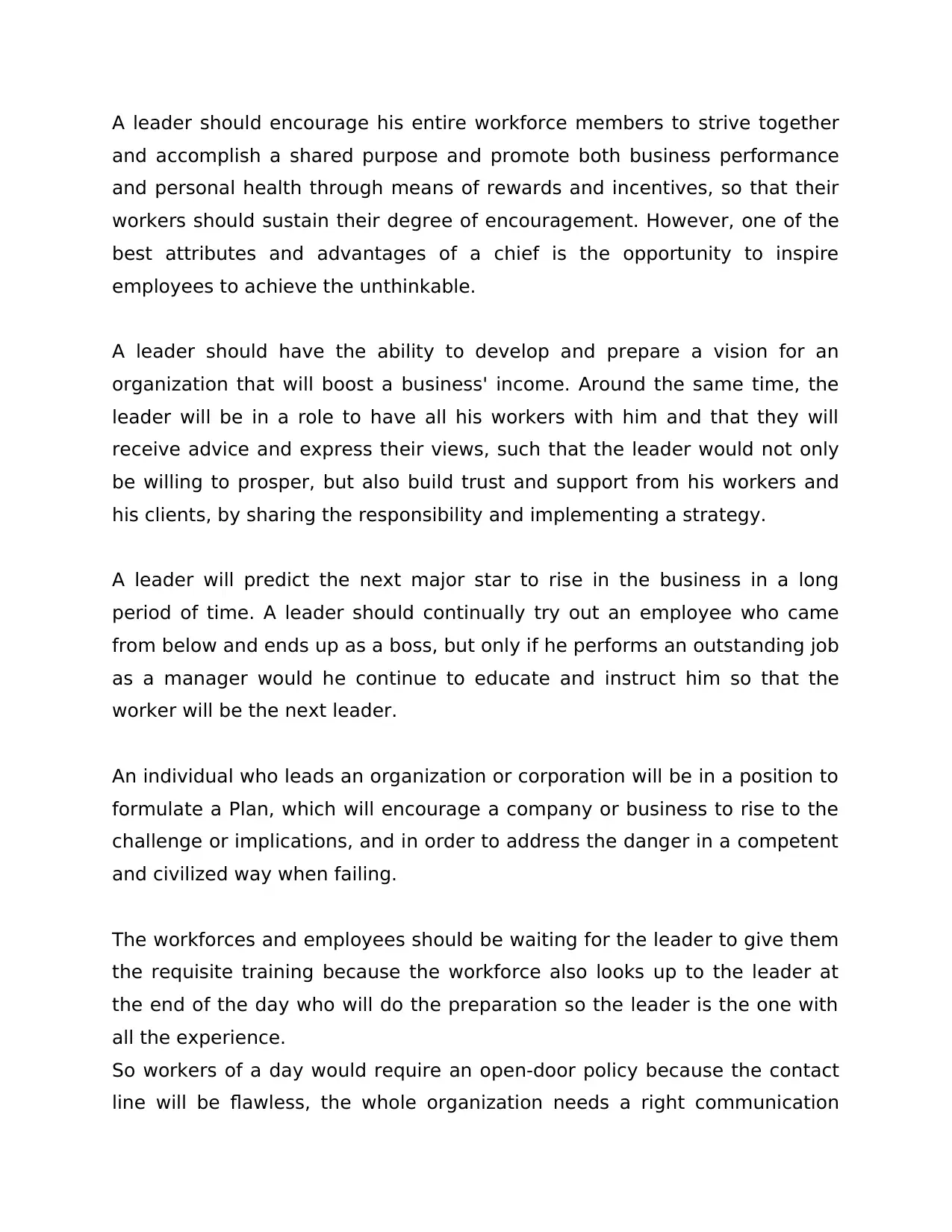
A leader should encourage his entire workforce members to strive together
and accomplish a shared purpose and promote both business performance
and personal health through means of rewards and incentives, so that their
workers should sustain their degree of encouragement. However, one of the
best attributes and advantages of a chief is the opportunity to inspire
employees to achieve the unthinkable.
A leader should have the ability to develop and prepare a vision for an
organization that will boost a business' income. Around the same time, the
leader will be in a role to have all his workers with him and that they will
receive advice and express their views, such that the leader would not only
be willing to prosper, but also build trust and support from his workers and
his clients, by sharing the responsibility and implementing a strategy.
A leader will predict the next major star to rise in the business in a long
period of time. A leader should continually try out an employee who came
from below and ends up as a boss, but only if he performs an outstanding job
as a manager would he continue to educate and instruct him so that the
worker will be the next leader.
An individual who leads an organization or corporation will be in a position to
formulate a Plan, which will encourage a company or business to rise to the
challenge or implications, and in order to address the danger in a competent
and civilized way when failing.
The workforces and employees should be waiting for the leader to give them
the requisite training because the workforce also looks up to the leader at
the end of the day who will do the preparation so the leader is the one with
all the experience.
So workers of a day would require an open-door policy because the contact
line will be flawless, the whole organization needs a right communication
and accomplish a shared purpose and promote both business performance
and personal health through means of rewards and incentives, so that their
workers should sustain their degree of encouragement. However, one of the
best attributes and advantages of a chief is the opportunity to inspire
employees to achieve the unthinkable.
A leader should have the ability to develop and prepare a vision for an
organization that will boost a business' income. Around the same time, the
leader will be in a role to have all his workers with him and that they will
receive advice and express their views, such that the leader would not only
be willing to prosper, but also build trust and support from his workers and
his clients, by sharing the responsibility and implementing a strategy.
A leader will predict the next major star to rise in the business in a long
period of time. A leader should continually try out an employee who came
from below and ends up as a boss, but only if he performs an outstanding job
as a manager would he continue to educate and instruct him so that the
worker will be the next leader.
An individual who leads an organization or corporation will be in a position to
formulate a Plan, which will encourage a company or business to rise to the
challenge or implications, and in order to address the danger in a competent
and civilized way when failing.
The workforces and employees should be waiting for the leader to give them
the requisite training because the workforce also looks up to the leader at
the end of the day who will do the preparation so the leader is the one with
all the experience.
So workers of a day would require an open-door policy because the contact
line will be flawless, the whole organization needs a right communication
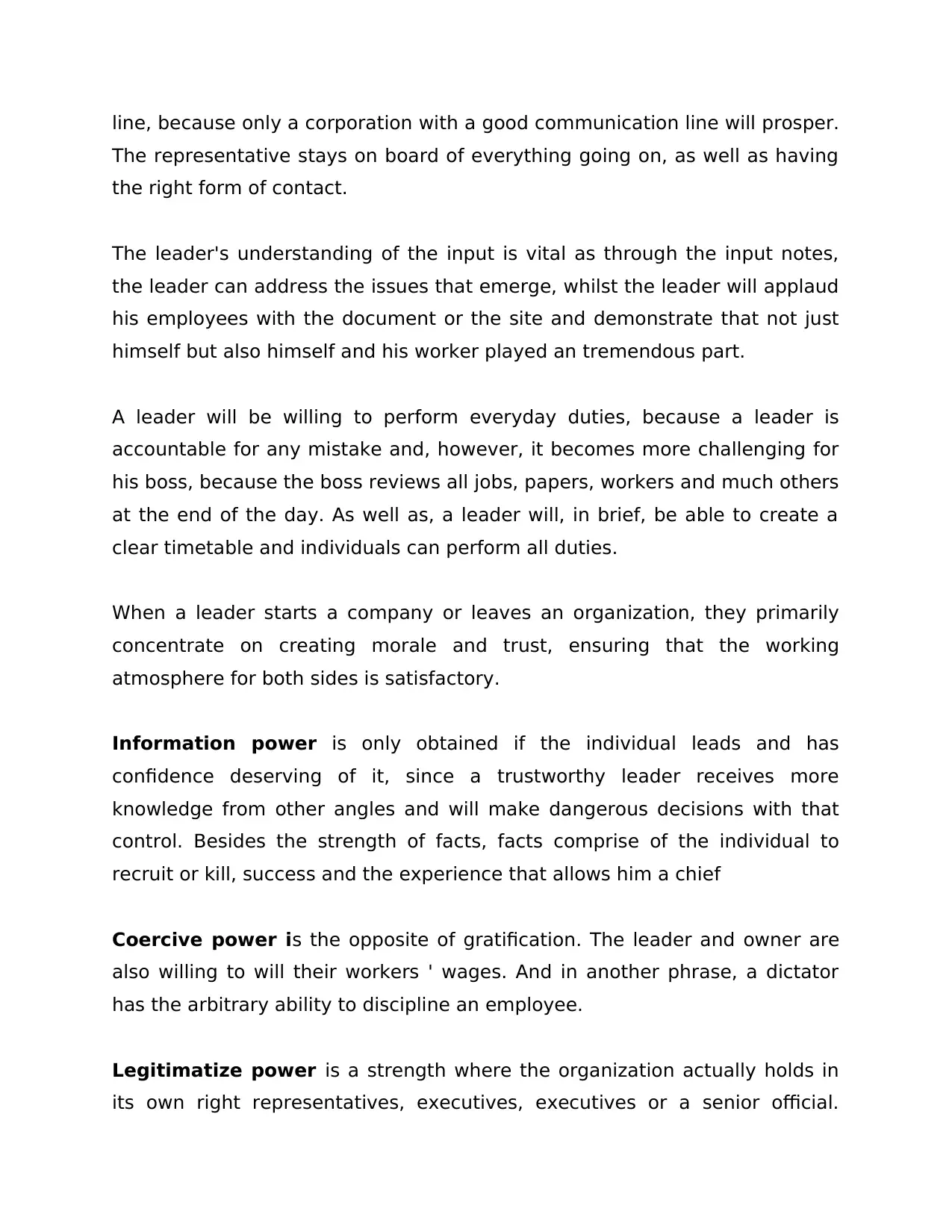
line, because only a corporation with a good communication line will prosper.
The representative stays on board of everything going on, as well as having
the right form of contact.
The leader's understanding of the input is vital as through the input notes,
the leader can address the issues that emerge, whilst the leader will applaud
his employees with the document or the site and demonstrate that not just
himself but also himself and his worker played an tremendous part.
A leader will be willing to perform everyday duties, because a leader is
accountable for any mistake and, however, it becomes more challenging for
his boss, because the boss reviews all jobs, papers, workers and much others
at the end of the day. As well as, a leader will, in brief, be able to create a
clear timetable and individuals can perform all duties.
When a leader starts a company or leaves an organization, they primarily
concentrate on creating morale and trust, ensuring that the working
atmosphere for both sides is satisfactory.
Information power is only obtained if the individual leads and has
confidence deserving of it, since a trustworthy leader receives more
knowledge from other angles and will make dangerous decisions with that
control. Besides the strength of facts, facts comprise of the individual to
recruit or kill, success and the experience that allows him a chief
Coercive power is the opposite of gratification. The leader and owner are
also willing to will their workers ' wages. And in another phrase, a dictator
has the arbitrary ability to discipline an employee.
Legitimatize power is a strength where the organization actually holds in
its own right representatives, executives, executives or a senior official.
The representative stays on board of everything going on, as well as having
the right form of contact.
The leader's understanding of the input is vital as through the input notes,
the leader can address the issues that emerge, whilst the leader will applaud
his employees with the document or the site and demonstrate that not just
himself but also himself and his worker played an tremendous part.
A leader will be willing to perform everyday duties, because a leader is
accountable for any mistake and, however, it becomes more challenging for
his boss, because the boss reviews all jobs, papers, workers and much others
at the end of the day. As well as, a leader will, in brief, be able to create a
clear timetable and individuals can perform all duties.
When a leader starts a company or leaves an organization, they primarily
concentrate on creating morale and trust, ensuring that the working
atmosphere for both sides is satisfactory.
Information power is only obtained if the individual leads and has
confidence deserving of it, since a trustworthy leader receives more
knowledge from other angles and will make dangerous decisions with that
control. Besides the strength of facts, facts comprise of the individual to
recruit or kill, success and the experience that allows him a chief
Coercive power is the opposite of gratification. The leader and owner are
also willing to will their workers ' wages. And in another phrase, a dictator
has the arbitrary ability to discipline an employee.
Legitimatize power is a strength where the organization actually holds in
its own right representatives, executives, executives or a senior official.
⊘ This is a preview!⊘
Do you want full access?
Subscribe today to unlock all pages.

Trusted by 1+ million students worldwide
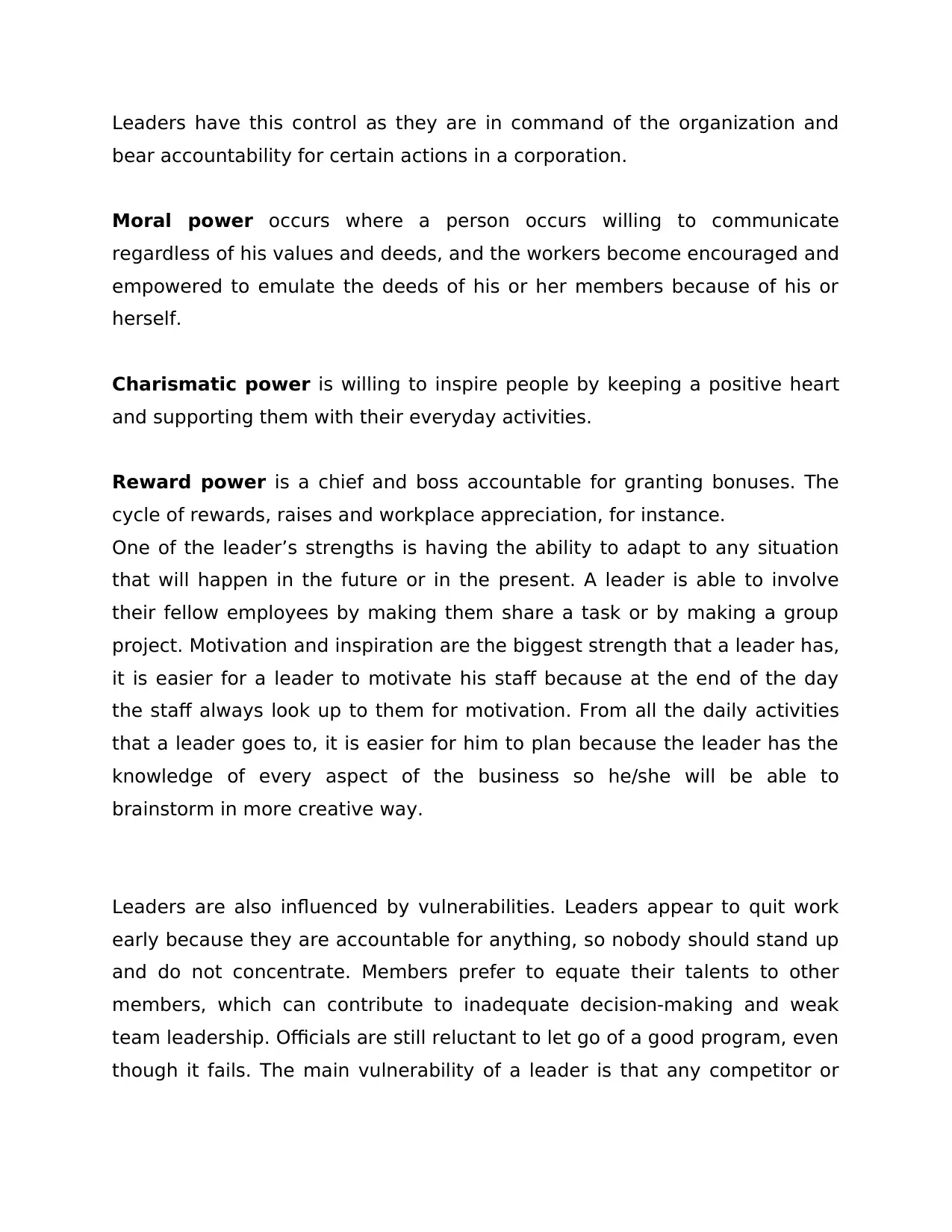
Leaders have this control as they are in command of the organization and
bear accountability for certain actions in a corporation.
Moral power occurs where a person occurs willing to communicate
regardless of his values and deeds, and the workers become encouraged and
empowered to emulate the deeds of his or her members because of his or
herself.
Charismatic power is willing to inspire people by keeping a positive heart
and supporting them with their everyday activities.
Reward power is a chief and boss accountable for granting bonuses. The
cycle of rewards, raises and workplace appreciation, for instance.
One of the leader’s strengths is having the ability to adapt to any situation
that will happen in the future or in the present. A leader is able to involve
their fellow employees by making them share a task or by making a group
project. Motivation and inspiration are the biggest strength that a leader has,
it is easier for a leader to motivate his staff because at the end of the day
the staff always look up to them for motivation. From all the daily activities
that a leader goes to, it is easier for him to plan because the leader has the
knowledge of every aspect of the business so he/she will be able to
brainstorm in more creative way.
Leaders are also influenced by vulnerabilities. Leaders appear to quit work
early because they are accountable for anything, so nobody should stand up
and do not concentrate. Members prefer to equate their talents to other
members, which can contribute to inadequate decision-making and weak
team leadership. Officials are still reluctant to let go of a good program, even
though it fails. The main vulnerability of a leader is that any competitor or
bear accountability for certain actions in a corporation.
Moral power occurs where a person occurs willing to communicate
regardless of his values and deeds, and the workers become encouraged and
empowered to emulate the deeds of his or her members because of his or
herself.
Charismatic power is willing to inspire people by keeping a positive heart
and supporting them with their everyday activities.
Reward power is a chief and boss accountable for granting bonuses. The
cycle of rewards, raises and workplace appreciation, for instance.
One of the leader’s strengths is having the ability to adapt to any situation
that will happen in the future or in the present. A leader is able to involve
their fellow employees by making them share a task or by making a group
project. Motivation and inspiration are the biggest strength that a leader has,
it is easier for a leader to motivate his staff because at the end of the day
the staff always look up to them for motivation. From all the daily activities
that a leader goes to, it is easier for him to plan because the leader has the
knowledge of every aspect of the business so he/she will be able to
brainstorm in more creative way.
Leaders are also influenced by vulnerabilities. Leaders appear to quit work
early because they are accountable for anything, so nobody should stand up
and do not concentrate. Members prefer to equate their talents to other
members, which can contribute to inadequate decision-making and weak
team leadership. Officials are still reluctant to let go of a good program, even
though it fails. The main vulnerability of a leader is that any competitor or
Paraphrase This Document
Need a fresh take? Get an instant paraphrase of this document with our AI Paraphraser
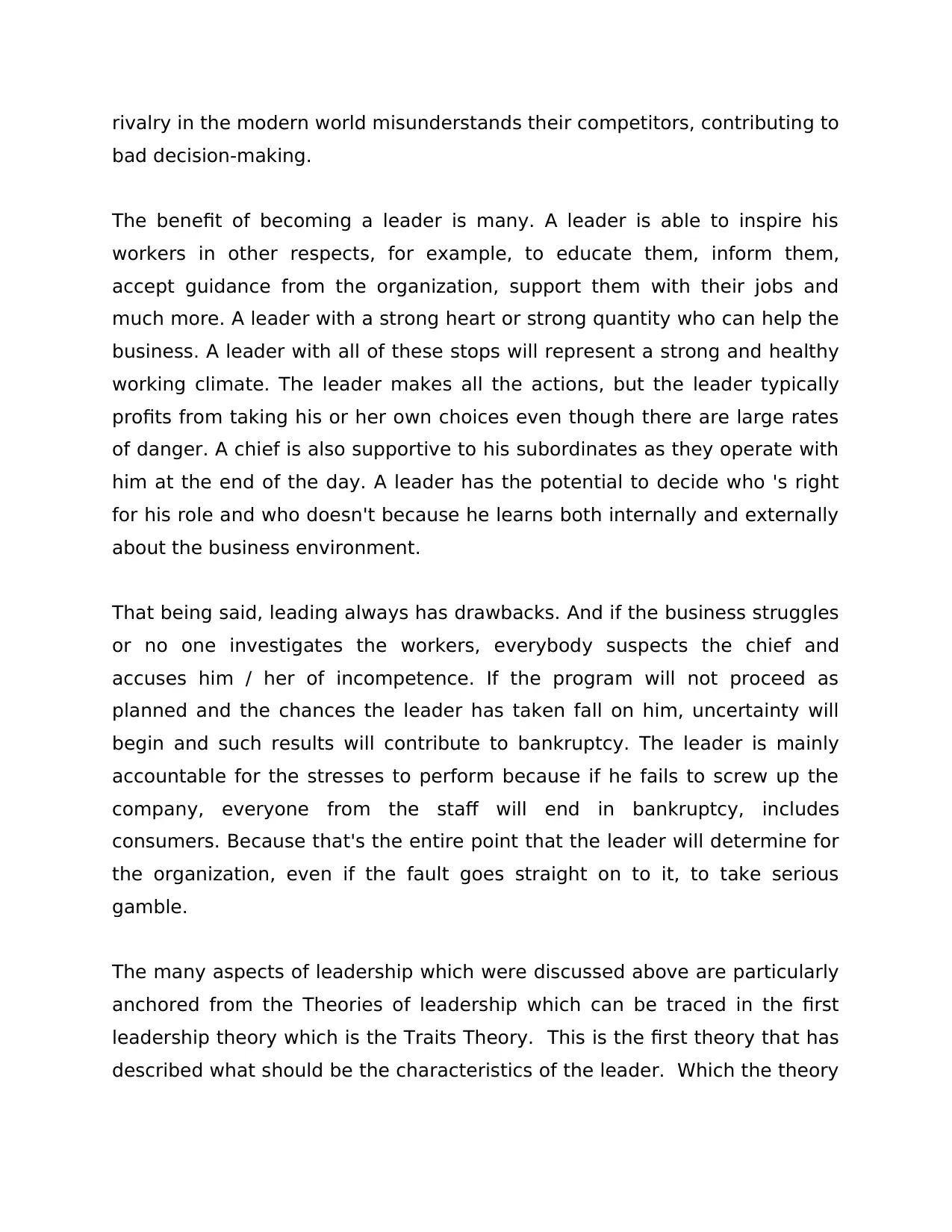
rivalry in the modern world misunderstands their competitors, contributing to
bad decision-making.
The benefit of becoming a leader is many. A leader is able to inspire his
workers in other respects, for example, to educate them, inform them,
accept guidance from the organization, support them with their jobs and
much more. A leader with a strong heart or strong quantity who can help the
business. A leader with all of these stops will represent a strong and healthy
working climate. The leader makes all the actions, but the leader typically
profits from taking his or her own choices even though there are large rates
of danger. A chief is also supportive to his subordinates as they operate with
him at the end of the day. A leader has the potential to decide who 's right
for his role and who doesn't because he learns both internally and externally
about the business environment.
That being said, leading always has drawbacks. And if the business struggles
or no one investigates the workers, everybody suspects the chief and
accuses him / her of incompetence. If the program will not proceed as
planned and the chances the leader has taken fall on him, uncertainty will
begin and such results will contribute to bankruptcy. The leader is mainly
accountable for the stresses to perform because if he fails to screw up the
company, everyone from the staff will end in bankruptcy, includes
consumers. Because that's the entire point that the leader will determine for
the organization, even if the fault goes straight on to it, to take serious
gamble.
The many aspects of leadership which were discussed above are particularly
anchored from the Theories of leadership which can be traced in the first
leadership theory which is the Traits Theory. This is the first theory that has
described what should be the characteristics of the leader. Which the theory
bad decision-making.
The benefit of becoming a leader is many. A leader is able to inspire his
workers in other respects, for example, to educate them, inform them,
accept guidance from the organization, support them with their jobs and
much more. A leader with a strong heart or strong quantity who can help the
business. A leader with all of these stops will represent a strong and healthy
working climate. The leader makes all the actions, but the leader typically
profits from taking his or her own choices even though there are large rates
of danger. A chief is also supportive to his subordinates as they operate with
him at the end of the day. A leader has the potential to decide who 's right
for his role and who doesn't because he learns both internally and externally
about the business environment.
That being said, leading always has drawbacks. And if the business struggles
or no one investigates the workers, everybody suspects the chief and
accuses him / her of incompetence. If the program will not proceed as
planned and the chances the leader has taken fall on him, uncertainty will
begin and such results will contribute to bankruptcy. The leader is mainly
accountable for the stresses to perform because if he fails to screw up the
company, everyone from the staff will end in bankruptcy, includes
consumers. Because that's the entire point that the leader will determine for
the organization, even if the fault goes straight on to it, to take serious
gamble.
The many aspects of leadership which were discussed above are particularly
anchored from the Theories of leadership which can be traced in the first
leadership theory which is the Traits Theory. This is the first theory that has
described what should be the characteristics of the leader. Which the theory
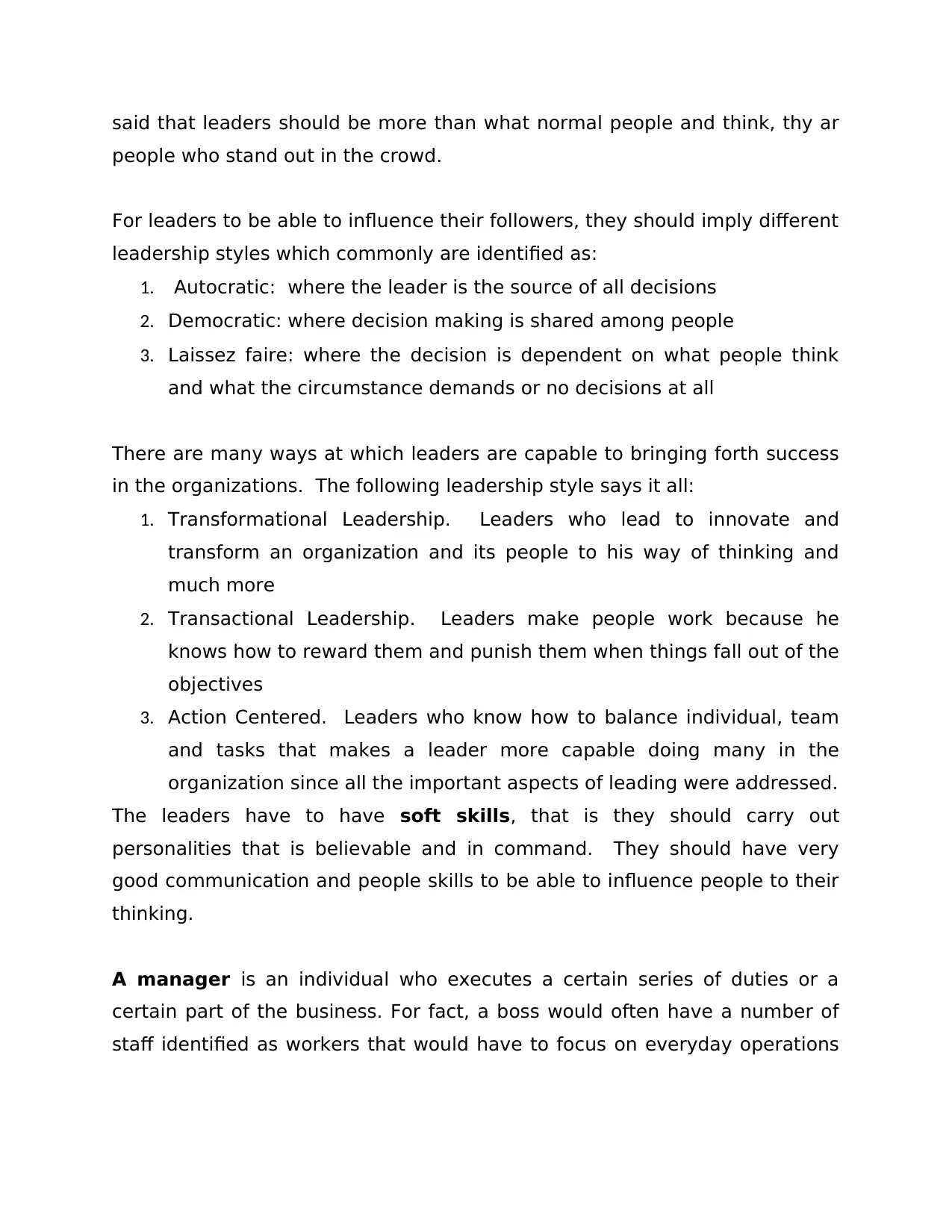
said that leaders should be more than what normal people and think, thy ar
people who stand out in the crowd.
For leaders to be able to influence their followers, they should imply different
leadership styles which commonly are identified as:
1. Autocratic: where the leader is the source of all decisions
2. Democratic: where decision making is shared among people
3. Laissez faire: where the decision is dependent on what people think
and what the circumstance demands or no decisions at all
There are many ways at which leaders are capable to bringing forth success
in the organizations. The following leadership style says it all:
1. Transformational Leadership. Leaders who lead to innovate and
transform an organization and its people to his way of thinking and
much more
2. Transactional Leadership. Leaders make people work because he
knows how to reward them and punish them when things fall out of the
objectives
3. Action Centered. Leaders who know how to balance individual, team
and tasks that makes a leader more capable doing many in the
organization since all the important aspects of leading were addressed.
The leaders have to have soft skills, that is they should carry out
personalities that is believable and in command. They should have very
good communication and people skills to be able to influence people to their
thinking.
A manager is an individual who executes a certain series of duties or a
certain part of the business. For fact, a boss would often have a number of
staff identified as workers that would have to focus on everyday operations
people who stand out in the crowd.
For leaders to be able to influence their followers, they should imply different
leadership styles which commonly are identified as:
1. Autocratic: where the leader is the source of all decisions
2. Democratic: where decision making is shared among people
3. Laissez faire: where the decision is dependent on what people think
and what the circumstance demands or no decisions at all
There are many ways at which leaders are capable to bringing forth success
in the organizations. The following leadership style says it all:
1. Transformational Leadership. Leaders who lead to innovate and
transform an organization and its people to his way of thinking and
much more
2. Transactional Leadership. Leaders make people work because he
knows how to reward them and punish them when things fall out of the
objectives
3. Action Centered. Leaders who know how to balance individual, team
and tasks that makes a leader more capable doing many in the
organization since all the important aspects of leading were addressed.
The leaders have to have soft skills, that is they should carry out
personalities that is believable and in command. They should have very
good communication and people skills to be able to influence people to their
thinking.
A manager is an individual who executes a certain series of duties or a
certain part of the business. For fact, a boss would often have a number of
staff identified as workers that would have to focus on everyday operations
⊘ This is a preview!⊘
Do you want full access?
Subscribe today to unlock all pages.

Trusted by 1+ million students worldwide
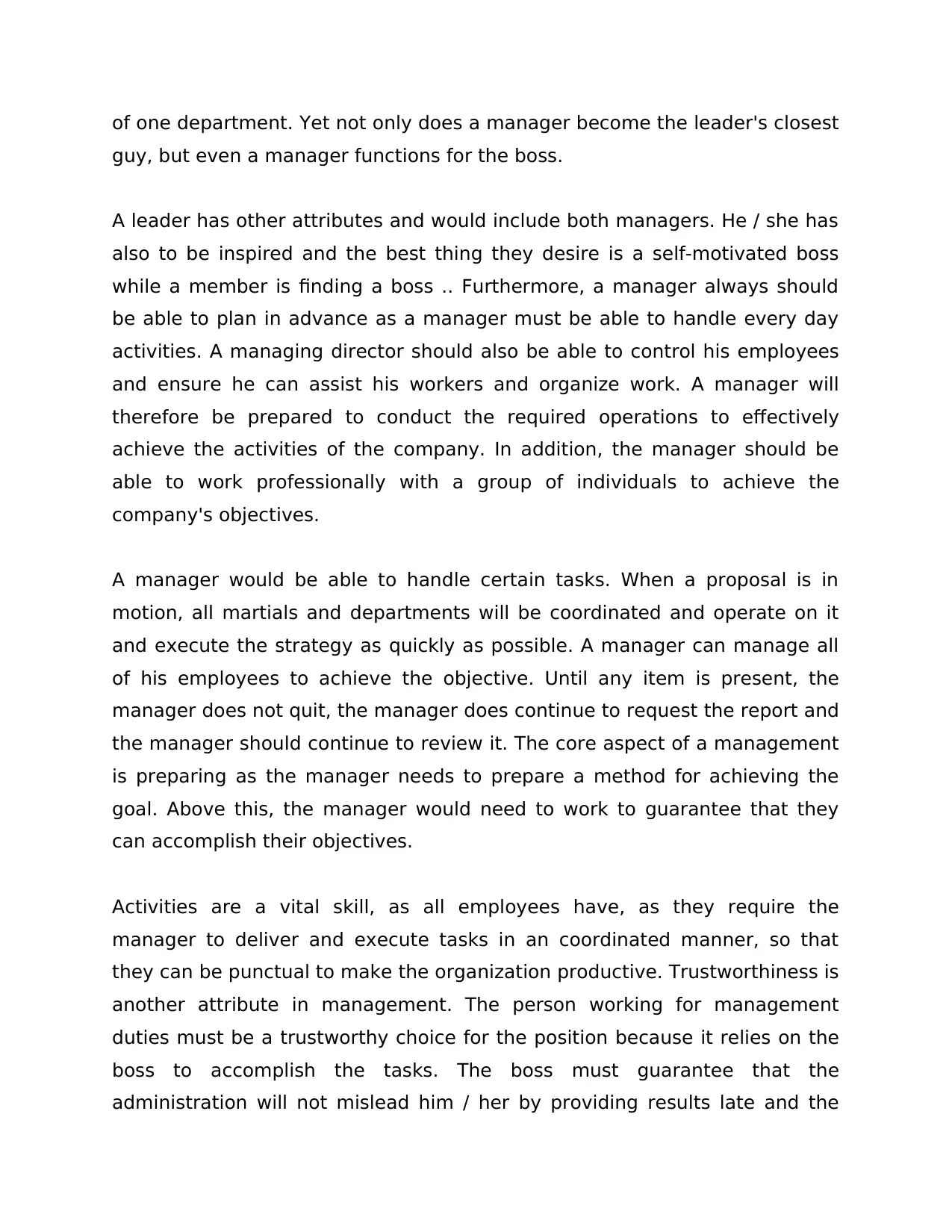
of one department. Yet not only does a manager become the leader's closest
guy, but even a manager functions for the boss.
A leader has other attributes and would include both managers. He / she has
also to be inspired and the best thing they desire is a self-motivated boss
while a member is finding a boss .. Furthermore, a manager always should
be able to plan in advance as a manager must be able to handle every day
activities. A managing director should also be able to control his employees
and ensure he can assist his workers and organize work. A manager will
therefore be prepared to conduct the required operations to effectively
achieve the activities of the company. In addition, the manager should be
able to work professionally with a group of individuals to achieve the
company's objectives.
A manager would be able to handle certain tasks. When a proposal is in
motion, all martials and departments will be coordinated and operate on it
and execute the strategy as quickly as possible. A manager can manage all
of his employees to achieve the objective. Until any item is present, the
manager does not quit, the manager does continue to request the report and
the manager should continue to review it. The core aspect of a management
is preparing as the manager needs to prepare a method for achieving the
goal. Above this, the manager would need to work to guarantee that they
can accomplish their objectives.
Activities are a vital skill, as all employees have, as they require the
manager to deliver and execute tasks in an coordinated manner, so that
they can be punctual to make the organization productive. Trustworthiness is
another attribute in management. The person working for management
duties must be a trustworthy choice for the position because it relies on the
boss to accomplish the tasks. The boss must guarantee that the
administration will not mislead him / her by providing results late and the
guy, but even a manager functions for the boss.
A leader has other attributes and would include both managers. He / she has
also to be inspired and the best thing they desire is a self-motivated boss
while a member is finding a boss .. Furthermore, a manager always should
be able to plan in advance as a manager must be able to handle every day
activities. A managing director should also be able to control his employees
and ensure he can assist his workers and organize work. A manager will
therefore be prepared to conduct the required operations to effectively
achieve the activities of the company. In addition, the manager should be
able to work professionally with a group of individuals to achieve the
company's objectives.
A manager would be able to handle certain tasks. When a proposal is in
motion, all martials and departments will be coordinated and operate on it
and execute the strategy as quickly as possible. A manager can manage all
of his employees to achieve the objective. Until any item is present, the
manager does not quit, the manager does continue to request the report and
the manager should continue to review it. The core aspect of a management
is preparing as the manager needs to prepare a method for achieving the
goal. Above this, the manager would need to work to guarantee that they
can accomplish their objectives.
Activities are a vital skill, as all employees have, as they require the
manager to deliver and execute tasks in an coordinated manner, so that
they can be punctual to make the organization productive. Trustworthiness is
another attribute in management. The person working for management
duties must be a trustworthy choice for the position because it relies on the
boss to accomplish the tasks. The boss must guarantee that the
administration will not mislead him / her by providing results late and the
Paraphrase This Document
Need a fresh take? Get an instant paraphrase of this document with our AI Paraphraser
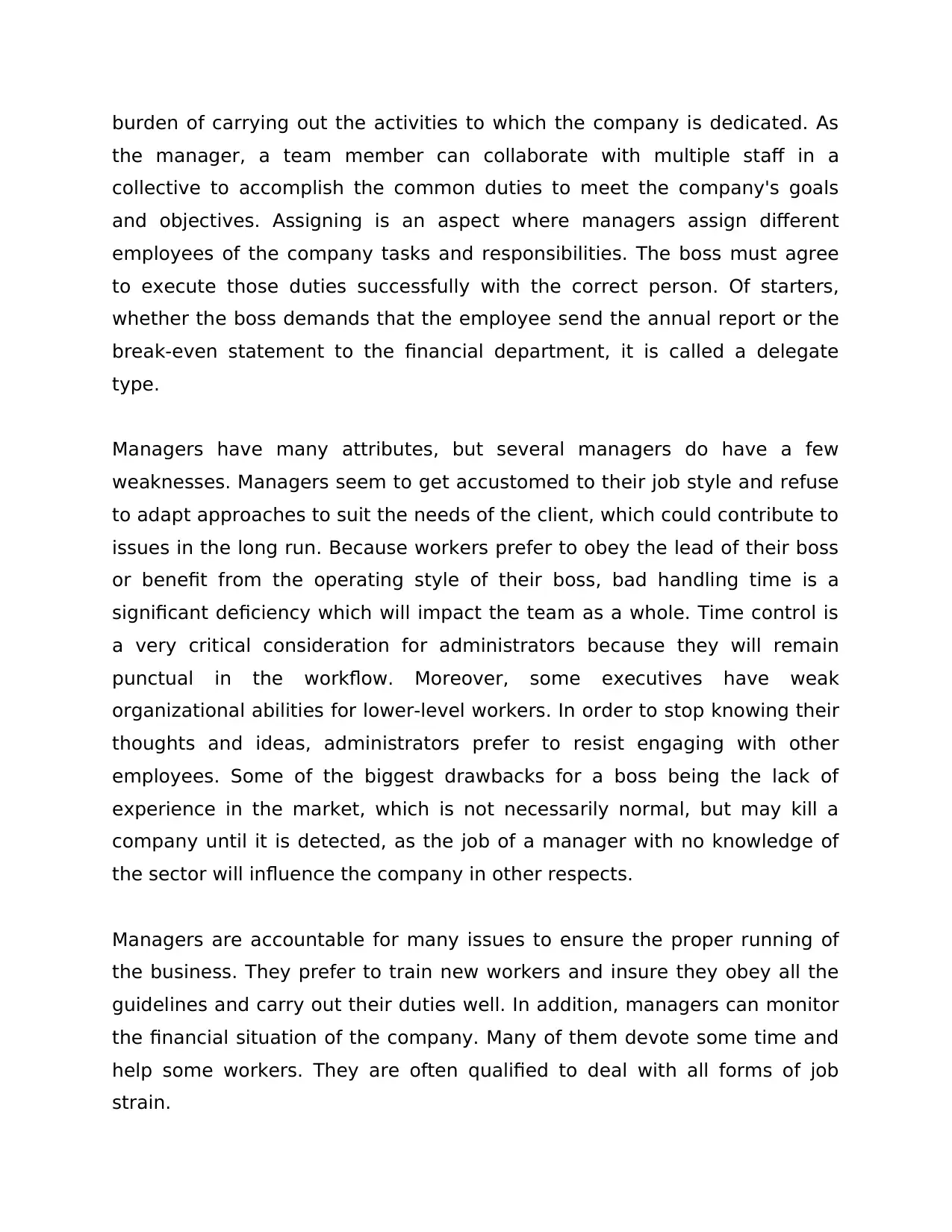
burden of carrying out the activities to which the company is dedicated. As
the manager, a team member can collaborate with multiple staff in a
collective to accomplish the common duties to meet the company's goals
and objectives. Assigning is an aspect where managers assign different
employees of the company tasks and responsibilities. The boss must agree
to execute those duties successfully with the correct person. Of starters,
whether the boss demands that the employee send the annual report or the
break-even statement to the financial department, it is called a delegate
type.
Managers have many attributes, but several managers do have a few
weaknesses. Managers seem to get accustomed to their job style and refuse
to adapt approaches to suit the needs of the client, which could contribute to
issues in the long run. Because workers prefer to obey the lead of their boss
or benefit from the operating style of their boss, bad handling time is a
significant deficiency which will impact the team as a whole. Time control is
a very critical consideration for administrators because they will remain
punctual in the workflow. Moreover, some executives have weak
organizational abilities for lower-level workers. In order to stop knowing their
thoughts and ideas, administrators prefer to resist engaging with other
employees. Some of the biggest drawbacks for a boss being the lack of
experience in the market, which is not necessarily normal, but may kill a
company until it is detected, as the job of a manager with no knowledge of
the sector will influence the company in other respects.
Managers are accountable for many issues to ensure the proper running of
the business. They prefer to train new workers and insure they obey all the
guidelines and carry out their duties well. In addition, managers can monitor
the financial situation of the company. Many of them devote some time and
help some workers. They are often qualified to deal with all forms of job
strain.
the manager, a team member can collaborate with multiple staff in a
collective to accomplish the common duties to meet the company's goals
and objectives. Assigning is an aspect where managers assign different
employees of the company tasks and responsibilities. The boss must agree
to execute those duties successfully with the correct person. Of starters,
whether the boss demands that the employee send the annual report or the
break-even statement to the financial department, it is called a delegate
type.
Managers have many attributes, but several managers do have a few
weaknesses. Managers seem to get accustomed to their job style and refuse
to adapt approaches to suit the needs of the client, which could contribute to
issues in the long run. Because workers prefer to obey the lead of their boss
or benefit from the operating style of their boss, bad handling time is a
significant deficiency which will impact the team as a whole. Time control is
a very critical consideration for administrators because they will remain
punctual in the workflow. Moreover, some executives have weak
organizational abilities for lower-level workers. In order to stop knowing their
thoughts and ideas, administrators prefer to resist engaging with other
employees. Some of the biggest drawbacks for a boss being the lack of
experience in the market, which is not necessarily normal, but may kill a
company until it is detected, as the job of a manager with no knowledge of
the sector will influence the company in other respects.
Managers are accountable for many issues to ensure the proper running of
the business. They prefer to train new workers and insure they obey all the
guidelines and carry out their duties well. In addition, managers can monitor
the financial situation of the company. Many of them devote some time and
help some workers. They are often qualified to deal with all forms of job
strain.
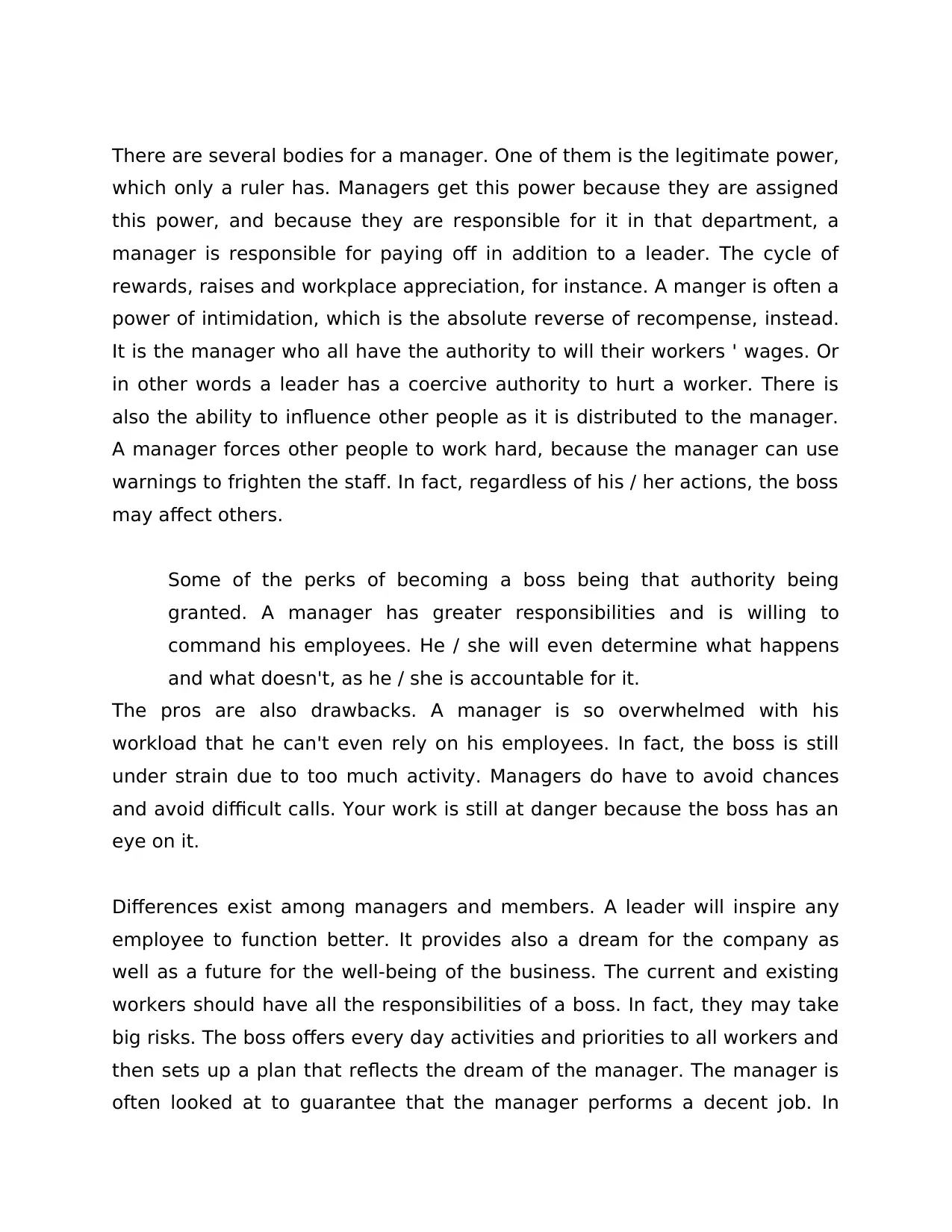
There are several bodies for a manager. One of them is the legitimate power,
which only a ruler has. Managers get this power because they are assigned
this power, and because they are responsible for it in that department, a
manager is responsible for paying off in addition to a leader. The cycle of
rewards, raises and workplace appreciation, for instance. A manger is often a
power of intimidation, which is the absolute reverse of recompense, instead.
It is the manager who all have the authority to will their workers ' wages. Or
in other words a leader has a coercive authority to hurt a worker. There is
also the ability to influence other people as it is distributed to the manager.
A manager forces other people to work hard, because the manager can use
warnings to frighten the staff. In fact, regardless of his / her actions, the boss
may affect others.
Some of the perks of becoming a boss being that authority being
granted. A manager has greater responsibilities and is willing to
command his employees. He / she will even determine what happens
and what doesn't, as he / she is accountable for it.
The pros are also drawbacks. A manager is so overwhelmed with his
workload that he can't even rely on his employees. In fact, the boss is still
under strain due to too much activity. Managers do have to avoid chances
and avoid difficult calls. Your work is still at danger because the boss has an
eye on it.
Differences exist among managers and members. A leader will inspire any
employee to function better. It provides also a dream for the company as
well as a future for the well-being of the business. The current and existing
workers should have all the responsibilities of a boss. In fact, they may take
big risks. The boss offers every day activities and priorities to all workers and
then sets up a plan that reflects the dream of the manager. The manager is
often looked at to guarantee that the manager performs a decent job. In
which only a ruler has. Managers get this power because they are assigned
this power, and because they are responsible for it in that department, a
manager is responsible for paying off in addition to a leader. The cycle of
rewards, raises and workplace appreciation, for instance. A manger is often a
power of intimidation, which is the absolute reverse of recompense, instead.
It is the manager who all have the authority to will their workers ' wages. Or
in other words a leader has a coercive authority to hurt a worker. There is
also the ability to influence other people as it is distributed to the manager.
A manager forces other people to work hard, because the manager can use
warnings to frighten the staff. In fact, regardless of his / her actions, the boss
may affect others.
Some of the perks of becoming a boss being that authority being
granted. A manager has greater responsibilities and is willing to
command his employees. He / she will even determine what happens
and what doesn't, as he / she is accountable for it.
The pros are also drawbacks. A manager is so overwhelmed with his
workload that he can't even rely on his employees. In fact, the boss is still
under strain due to too much activity. Managers do have to avoid chances
and avoid difficult calls. Your work is still at danger because the boss has an
eye on it.
Differences exist among managers and members. A leader will inspire any
employee to function better. It provides also a dream for the company as
well as a future for the well-being of the business. The current and existing
workers should have all the responsibilities of a boss. In fact, they may take
big risks. The boss offers every day activities and priorities to all workers and
then sets up a plan that reflects the dream of the manager. The manager is
often looked at to guarantee that the manager performs a decent job. In
⊘ This is a preview!⊘
Do you want full access?
Subscribe today to unlock all pages.

Trusted by 1+ million students worldwide
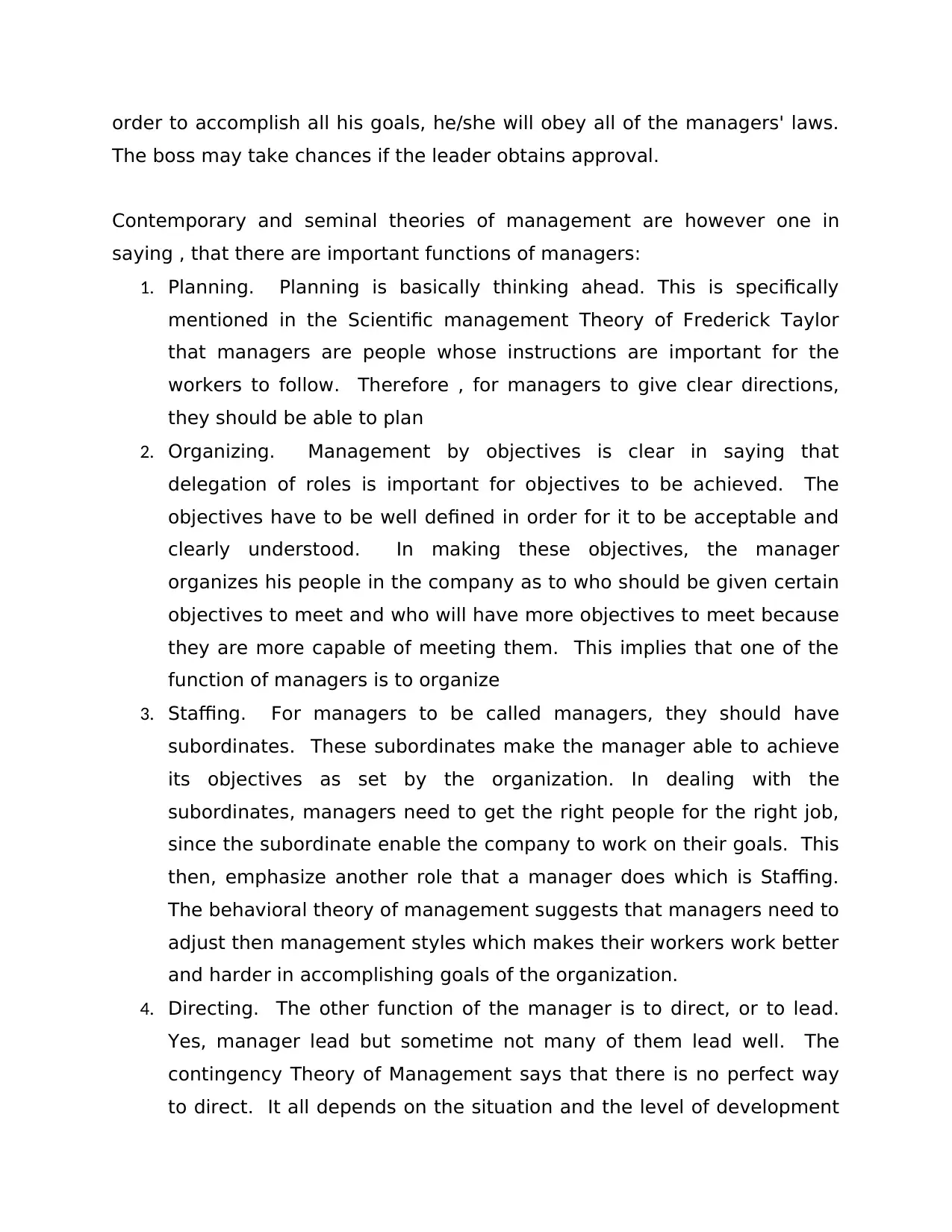
order to accomplish all his goals, he/she will obey all of the managers' laws.
The boss may take chances if the leader obtains approval.
Contemporary and seminal theories of management are however one in
saying , that there are important functions of managers:
1. Planning. Planning is basically thinking ahead. This is specifically
mentioned in the Scientific management Theory of Frederick Taylor
that managers are people whose instructions are important for the
workers to follow. Therefore , for managers to give clear directions,
they should be able to plan
2. Organizing. Management by objectives is clear in saying that
delegation of roles is important for objectives to be achieved. The
objectives have to be well defined in order for it to be acceptable and
clearly understood. In making these objectives, the manager
organizes his people in the company as to who should be given certain
objectives to meet and who will have more objectives to meet because
they are more capable of meeting them. This implies that one of the
function of managers is to organize
3. Staffing. For managers to be called managers, they should have
subordinates. These subordinates make the manager able to achieve
its objectives as set by the organization. In dealing with the
subordinates, managers need to get the right people for the right job,
since the subordinate enable the company to work on their goals. This
then, emphasize another role that a manager does which is Staffing.
The behavioral theory of management suggests that managers need to
adjust then management styles which makes their workers work better
and harder in accomplishing goals of the organization.
4. Directing. The other function of the manager is to direct, or to lead.
Yes, manager lead but sometime not many of them lead well. The
contingency Theory of Management says that there is no perfect way
to direct. It all depends on the situation and the level of development
The boss may take chances if the leader obtains approval.
Contemporary and seminal theories of management are however one in
saying , that there are important functions of managers:
1. Planning. Planning is basically thinking ahead. This is specifically
mentioned in the Scientific management Theory of Frederick Taylor
that managers are people whose instructions are important for the
workers to follow. Therefore , for managers to give clear directions,
they should be able to plan
2. Organizing. Management by objectives is clear in saying that
delegation of roles is important for objectives to be achieved. The
objectives have to be well defined in order for it to be acceptable and
clearly understood. In making these objectives, the manager
organizes his people in the company as to who should be given certain
objectives to meet and who will have more objectives to meet because
they are more capable of meeting them. This implies that one of the
function of managers is to organize
3. Staffing. For managers to be called managers, they should have
subordinates. These subordinates make the manager able to achieve
its objectives as set by the organization. In dealing with the
subordinates, managers need to get the right people for the right job,
since the subordinate enable the company to work on their goals. This
then, emphasize another role that a manager does which is Staffing.
The behavioral theory of management suggests that managers need to
adjust then management styles which makes their workers work better
and harder in accomplishing goals of the organization.
4. Directing. The other function of the manager is to direct, or to lead.
Yes, manager lead but sometime not many of them lead well. The
contingency Theory of Management says that there is no perfect way
to direct. It all depends on the situation and the level of development
Paraphrase This Document
Need a fresh take? Get an instant paraphrase of this document with our AI Paraphraser
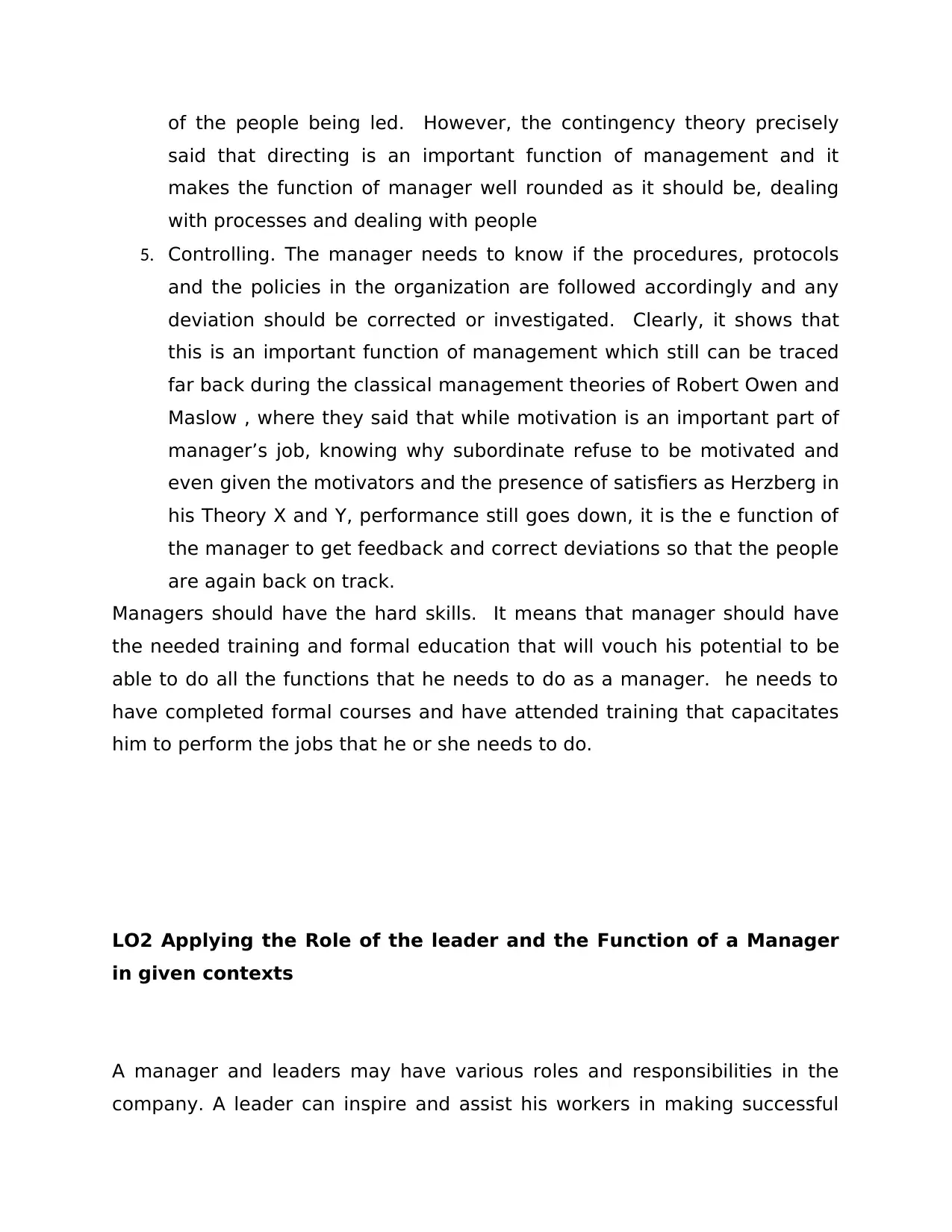
of the people being led. However, the contingency theory precisely
said that directing is an important function of management and it
makes the function of manager well rounded as it should be, dealing
with processes and dealing with people
5. Controlling. The manager needs to know if the procedures, protocols
and the policies in the organization are followed accordingly and any
deviation should be corrected or investigated. Clearly, it shows that
this is an important function of management which still can be traced
far back during the classical management theories of Robert Owen and
Maslow , where they said that while motivation is an important part of
manager’s job, knowing why subordinate refuse to be motivated and
even given the motivators and the presence of satisfiers as Herzberg in
his Theory X and Y, performance still goes down, it is the e function of
the manager to get feedback and correct deviations so that the people
are again back on track.
Managers should have the hard skills. It means that manager should have
the needed training and formal education that will vouch his potential to be
able to do all the functions that he needs to do as a manager. he needs to
have completed formal courses and have attended training that capacitates
him to perform the jobs that he or she needs to do.
LO2 Applying the Role of the leader and the Function of a Manager
in given contexts
A manager and leaders may have various roles and responsibilities in the
company. A leader can inspire and assist his workers in making successful
said that directing is an important function of management and it
makes the function of manager well rounded as it should be, dealing
with processes and dealing with people
5. Controlling. The manager needs to know if the procedures, protocols
and the policies in the organization are followed accordingly and any
deviation should be corrected or investigated. Clearly, it shows that
this is an important function of management which still can be traced
far back during the classical management theories of Robert Owen and
Maslow , where they said that while motivation is an important part of
manager’s job, knowing why subordinate refuse to be motivated and
even given the motivators and the presence of satisfiers as Herzberg in
his Theory X and Y, performance still goes down, it is the e function of
the manager to get feedback and correct deviations so that the people
are again back on track.
Managers should have the hard skills. It means that manager should have
the needed training and formal education that will vouch his potential to be
able to do all the functions that he needs to do as a manager. he needs to
have completed formal courses and have attended training that capacitates
him to perform the jobs that he or she needs to do.
LO2 Applying the Role of the leader and the Function of a Manager
in given contexts
A manager and leaders may have various roles and responsibilities in the
company. A leader can inspire and assist his workers in making successful
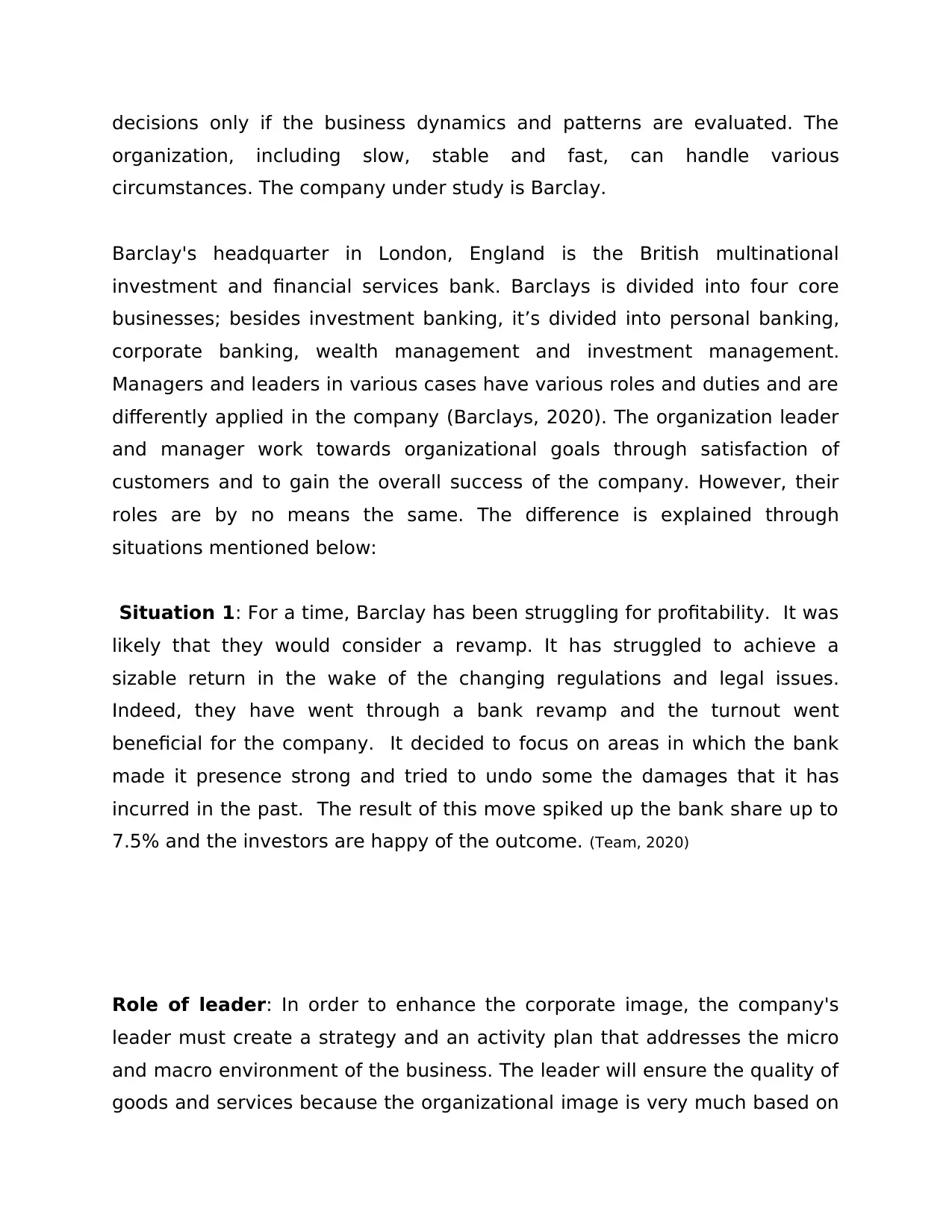
decisions only if the business dynamics and patterns are evaluated. The
organization, including slow, stable and fast, can handle various
circumstances. The company under study is Barclay.
Barclay's headquarter in London, England is the British multinational
investment and financial services bank. Barclays is divided into four core
businesses; besides investment banking, it’s divided into personal banking,
corporate banking, wealth management and investment management.
Managers and leaders in various cases have various roles and duties and are
differently applied in the company (Barclays, 2020). The organization leader
and manager work towards organizational goals through satisfaction of
customers and to gain the overall success of the company. However, their
roles are by no means the same. The difference is explained through
situations mentioned below:
Situation 1: For a time, Barclay has been struggling for profitability. It was
likely that they would consider a revamp. It has struggled to achieve a
sizable return in the wake of the changing regulations and legal issues.
Indeed, they have went through a bank revamp and the turnout went
beneficial for the company. It decided to focus on areas in which the bank
made it presence strong and tried to undo some the damages that it has
incurred in the past. The result of this move spiked up the bank share up to
7.5% and the investors are happy of the outcome. (Team, 2020)
Role of leader: In order to enhance the corporate image, the company's
leader must create a strategy and an activity plan that addresses the micro
and macro environment of the business. The leader will ensure the quality of
goods and services because the organizational image is very much based on
organization, including slow, stable and fast, can handle various
circumstances. The company under study is Barclay.
Barclay's headquarter in London, England is the British multinational
investment and financial services bank. Barclays is divided into four core
businesses; besides investment banking, it’s divided into personal banking,
corporate banking, wealth management and investment management.
Managers and leaders in various cases have various roles and duties and are
differently applied in the company (Barclays, 2020). The organization leader
and manager work towards organizational goals through satisfaction of
customers and to gain the overall success of the company. However, their
roles are by no means the same. The difference is explained through
situations mentioned below:
Situation 1: For a time, Barclay has been struggling for profitability. It was
likely that they would consider a revamp. It has struggled to achieve a
sizable return in the wake of the changing regulations and legal issues.
Indeed, they have went through a bank revamp and the turnout went
beneficial for the company. It decided to focus on areas in which the bank
made it presence strong and tried to undo some the damages that it has
incurred in the past. The result of this move spiked up the bank share up to
7.5% and the investors are happy of the outcome. (Team, 2020)
Role of leader: In order to enhance the corporate image, the company's
leader must create a strategy and an activity plan that addresses the micro
and macro environment of the business. The leader will ensure the quality of
goods and services because the organizational image is very much based on
⊘ This is a preview!⊘
Do you want full access?
Subscribe today to unlock all pages.

Trusted by 1+ million students worldwide
1 out of 26
Related Documents
Your All-in-One AI-Powered Toolkit for Academic Success.
+13062052269
info@desklib.com
Available 24*7 on WhatsApp / Email
![[object Object]](/_next/static/media/star-bottom.7253800d.svg)
Unlock your academic potential
Copyright © 2020–2025 A2Z Services. All Rights Reserved. Developed and managed by ZUCOL.



